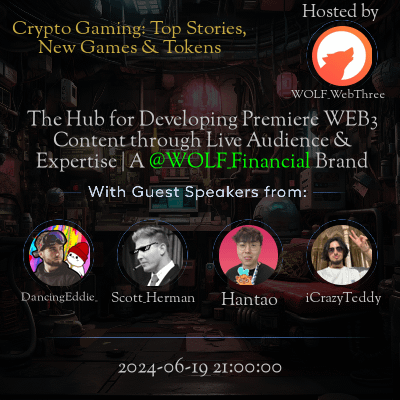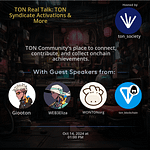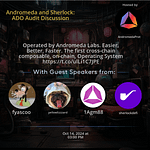This space is hosted by WOLF_WebThree
Space Summary
This Twitter Space highlighted the complexities and opportunities within the gaming industry amid the rise of Web3 technologies. The panelists shared valuable insights into the significance of community engagement and the impacts of meme coins on the market. Discussions also revolved around the integration of Web3 concepts, such as NFTs and socialFi, into gaming projects. Despite the challenges developers face, such as navigating market dynamics and meeting community expectations, the speakers remained optimistic about the future. Innovation and strategic alignments emerged as key themes for sustaining success and growth in this rapidly evolving field. The space ended with practical advice for aspiring developers, emphasizing the roles of engagement, innovation, and leveraging emerging technologies.
Questions
Q: What is crucial for success in the gaming industry?
A: Building a strong community and active engagement.
Q: How have meme coins affected the market?
A: They have dominated the market, bringing a mix of enthusiasm and cynicism.
Q: How can gaming integrate with Web3 projects?
A: By aligning gaming projects with Web3 concepts, leveraging NFTs and socialFi.
Q: What are the primary challenges developers face?
A: Navigating market dynamics and community expectations.
Q: What is the current trend in NFT gaming?
A: A surge in interest and innovative projects.
Q: How does socialFi enhance gaming?
A: By providing richer, more engaging experiences for users.
Q: What strategies work for aligning gaming projects with broader initiatives?
A: Collaboration and strategic partnerships with established projects.
Q: What are the speakers’ projections for the future of gaming?
A: Continued innovation and expanding integration with Web3.
Q: Why is innovation crucial in this field?
A: To stay ahead and keep the community engaged.
Q: How should aspiring developers approach the gaming industry?
A: By focusing on community building, engaging content, and leveraging emerging technologies.
Highlights
Time: 00:00:05
Introduction and kick-off of the discussion.
Time: 00:10:15
Importance of community engagement.
Time: 00:20:30
Impact of meme coins on the market.
Time: 00:30:45
Integration of Web3 concepts in gaming projects.
Time: 00:40:10
Challenges faced by developers in the current market.
Time: 00:50:25
Insights into NFT gaming trends and future projections.
Time: 01:00:45
Role of socialFi in enhancing user experiences in gaming.
Time: 01:10:15
Strategies for aligning gaming with broader Web3 projects.
Time: 01:20:25
Importance of innovation and staying ahead in the industry.
Time: 01:30:45
Advice for aspiring developers entering the gaming field.
Time: 01:40:10
Closing remarks and final thoughts from the speakers.
Key Takeaways
- The significance of community engagement in gaming.
- The impact of meme coins on the market.
- Integration of Web3 concepts in gaming.
- Challenges faced by gaming developers.
- The evolving landscape of NFT gaming.
- Role of socialFi in enhancing gaming experiences.
- Strategies for aligning gaming with broader projects.
- Insights into achieving success in the gaming industry.
- Importance of innovation and staying ahead in gaming.
- Future projections for the gaming industry.
Behind the Mic
all it as content creators. One actually cool metric, quick little case study I want to throw in for you guys is I work with a few big youtubers and one of them had Shroud watching a video we helped create. Now, Shroud’s a massive streamer, but we used his sort of overview or his understanding of what content is. Every streamer watches certain pieces of content when they do reaction content, especially these gamers, because it’s easy content to make, but they also want to keep it entertaining. So they want to have a mix of tension and fun. One of the things we did was we watched Shroud’s reaction to one of our videos that we created as a team and just used basic things like gaze detection to see. When does this accomplish? The large creator notice moments of tension and fun? Or when do they look away and look at their stream and or might forward the video? So yeah, man, love me a bit of fun, love me a bit attention. But tying those together can sometimes give you some great fireworks. Damn, I really like Teddy’s take on this and I think I have some insights also from myself. I feel like fun in the context of games. Most of the time when you pick up a game, you do it because you’re bored. I feel like fun is the removal of that so it occupies your time and you stay engaged doing it. Right. I do think that in games fundamentally models that are the most successful is one, it gives you a lot of dopamine, like immediate dopamine, right? And two, I think the other type of game would probably be like a progression game where you feel like you’re fundamentally making progress whether like it’s in a game, you know, whether it’s like growing your town hall or you know, you’re starring up your characters. I think if you’re able to perfect these two loops really well, your game will be really fun. Yeah. I want to bring on Hanto into the conversation. He came up a little while ago. Good to have you, man. Didn’t know if you want to weigh on, weigh in on any thoughts otherwise, I also have a new question, new topic for us to explore, but I want to make sure we capture all the good insights. So what’s on your mind, man? Yeah, thanks for having me on. This is fun. And I like the idea of combining friction and fun, but I think fundamentally, like friction is an aspect of fun. If games are too easy, you know, you get bored of them. And I think I like to think of friction as a form of challenge, right? Like that’s what gets you engaged. And so it’s kind of an essential aspect of fun when you’re playing a game. So challenge has to be part of that fun loop, and that’s really essential for making a good game experience. I love that, man. And, you know, there’s something you just said earlier on about, you know, the nature of content right now, how it’s interacting with the gaming world, especially who was it before talking about the nature of attention span and immediate dopamine hits. That’s a really important part of it, right? Because I think that if we apply concepts like gaze detection, these are all tools now, or any derivative of that, to understand how these forms of friction and fun work together. We can essentially create games that are not just enjoyable but also fulfilling for players over long periods of time. Because I think one of the challenges that we sometimes see is that some games are super fun to begin with, but they lack long-term engagement. So it’s really fascinating to think about how you can maintain that over time. Yeah, I wanted to hop in a little bit on the technicalities of that. You know, we have to think about the mechanisms within games that essentially drive engagement. So obviously, if we’re thinking about friction, right, sometimes that comes in the form of difficulty. But you also want to make sure that you don’t make things so difficult that they become frustrating. There’s a sweet spot you have to hit. And the interesting part is, you know, as the game’s AI gets better, we can start to dynamically adjust difficulty to match the player’s skill level. And that kind of dynamic adjustment can create a perpetual sense of flow and engagement for the player. Yeah, Shaolin, I see your hand up. You had something to add here too? Go ahead, man. Yeah, for sure. So one thing I wanted to touch on is the importance of reward systems. You know, a lot of people get this feedback loop mechanism pretty well understood. But it goes beyond just difficulty adjustments, it’s also about rewarding players appropriately. You’ve got to mix short-term rewards with long-term goals. The short-term gives you that immediate dopamine hit, like you’re talking about, and the long-term keeps you engaged over weeks and months. You know, that’s why Battle Passes in games like Fortnite are so effective because they’re a combination of short-term and long-term rewards. Exactly, and I think there’s an often overlooked point in the way these systems interact with the player’s psychology. When you have these layered reward systems, what happens is you’re able to keep multiple types of players engaged, whether they’re casuals who play occasionally or hardcore gamers who are grinding daily. Right, and beyond that, I think we need to think about the narrative structure within the gaming experience as well. A compelling story can drive engagement even further. I mean, people often overlook how good storytelling can make gameplay mechanics more immersive. Take something like Red Dead Redemption 2, which weaves its game mechanics into a deeply engaging story. That kind of narrative complexity keeps players coming back because they’re not just playing for the mechanics—they’re invested in the world itself. The funny thing about games, though, especially right now in the Web3 space, is ensuring that user-generated content can also be a significant component. With blockchain technology, you can create ecosystems where players contribute to the game world in meaningful ways. Yeah, completely. And I think what’s incredibly exciting is that as we start integrating these new technologies, we can create much richer, more engaging experiences for players. It’s not just about more complex game mechanics, but also about empowering the players to feel like they’re genuinely a part of that world. Right, and that’s something traditionally you couldn’t really do on Web2 platforms. Blockchain allows for a kind of ownership and exchange that wasn’t possible before, and it opens up so many possibilities for more interactive and engaging worlds. Absolutely. One great example of how blockchain can be used is in reward distribution. Players can be rewarded in a meaningful way that holds real-world value, and this can drastically enhance engagement. I want to jump in real quick. I think this is a really exciting area and it’s kinda untapped right now. As we see more games integrating NFTs or blockchain mechanics, it’s not just about the tech. It’s about using it to actually enhance player experience without it feeling forced or gimmicky. Yeah, that’s spot on. While the tech is fascinating, the end goal is always to make the game more fun, more engaging, and more rewarding for the player. If we can strike that balance, there’s a ton of potential here. Absolutely. It’s been great hearing everyone’s thoughts. The dynamic between friction and fun, as well as how we can use new technologies to enhance engagement, are definitely key topics for the future of gaming. I think we’ve covered a lot of great points today. Anyone have any final thoughts or shall we wrap it up here? Just wanted to echo that sentiment and thank all the speakers for their incredible insights. This has been a really enriching discussion, and I’ve learned quite a bit. Thank you all for sharing your expertise. Yeah, same here. This has been really enlightening. Thanks, everyone, for their inputs. It’s always great to hear different perspectives on these issues. I appreciate it. All right, on that note, I think we should call it a wrap. Big thank you to everyone who joined and shared their thoughts. Looking forward to more discussions like this in the future. Absolutely, thank you all. This will be my final space. I’ll be checking out till 2029. See you all later. Yeah. I was gonna say, which bull run is gonna help my NFT floor come back up? Because my shit’s in the dumps from last bull run, baby. Do I gotta wait till 2029 or 2025? Next floor. No, no 2025, you guys. Next year. Next year. Stay around. Where you going? All right. Dang, bro. Eddie, you have any thoughts on this conversation so far? What are you thinking? I mean, I don’t know. I don’t know about, like, I don’t know about timing bull runs or whatever. Although, God, man, I do. I would love to see some NFT play again. It’s actually been a little bit frustrating to watch the meme coins kind of, like, I don’t have anything against meme coins. I just have a little bit of sadness that it has been explicitly meme coins that have come to the forefront instead of more meaningful blockchain technologies like NFTs and decentralized applications. Yeah, I hear you. It feels like the focus has shifted, but I think it typically does in cycles. Hopefully, we’ll see a resurgence soon. Honestly, this is something that’s been on my mind too. With the way these market cycles go, it always feels like valuable innovations get overshadowed by trends. But, you know, that’s just how it is sometimes. Alright, I think we’ve covered a lot of ground today. Thanks again to everyone for your contributions. It’s been a really insightful discussion and I’m sure we’ll have many more like this in the future. You guys take care. Absolutely, take care everyone. Bye. Bye. Take care. Bye everyone. See ya. Goodbye. Be well. Lates. Peace out of you. This is going to be a wrap.







